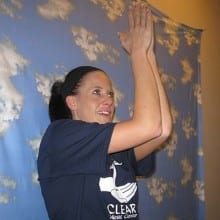Stretching is very beneficial for people with scoliosis. With scoliosis, the muscles on one side of the body become very tight, and need to be stretched regularly to help them relax. On the other side, the muscles become weaker, and need to be strengthened with isometric exercises. For more information about isometric exercises, please visit the section on back exercises.
Please note that, for a more effective and comprehensive exercise program using scoliosis stretches, it is necessary to consult with a CLEAR certified doctor directly. CLEAR Institute is not responsible for the success or lack thereof that may result as a consequence of performing these scoliosis stretches, nor can we be held liable for any injuries or negative side effects that may occur. Please perform these exercises carefully and follow all instructions. By doing these scoliosis stretches, you acknowledge that it is at your own risk.

This stretch can be performed standing or seated. Place one hand on the side of your body where your scoliosis curves towards, and press in slightly. Use this hand as a fulcrum, keeping continual pressure as you bend in that direction.
This exercise can be done in both directions for double major curves. It should be repeated 50 to 100 times.
The piriformis muscle is a fan-shaped muscle that attaches from your hips to your tailbone. It can become tight on the side of the hip that rotates forward; in a classic “S”-shaped case of scoliosis, where the upper curve goes to the right away from the heart, and the lower curve goes to the left, the right piriformis tends to be tight.
To perform this exercise, sit down on the floor and cross the leg on the side you’d like to stretch, over the opposite leg. Bend the knee and hug it to your chest with your arms. You should feel the stretch just below your hips, along the top of the buttocks. Hold this for at least ten seconds, and repeat ten times.

This stretches the rhomboid muscles between the shoulder blades. It is performed by placing the palms and elbows together in front of the body, then slowly raising the arms up while keeping the fingers pointed straight up and the arms held out in front of the body (don’t bring them back over the head). Hold for sixty seconds.

The psoas muscle attaches from the inside of the top of the thigh bone to the fronts and sides of the spinal bones in the low back. It has a very powerful effect upon derotation of the vertebrae in the lumbar spine. This stretch is only done if there is a lumbar scoliosis.
If the curve in your low back goes to the left, this exercise will be performed on the right.
To stretch the right psoas, kneel on the right knee with the left leg in front. Raise the right arm up, and gradually lean your body forward. If this maneuver is too difficult, you can also place the left knee up on a chair or box and do it standing, rather than kneeling. Hold for sixty seconds.
For additional information about scoliosis stretches, please visit our Physical Therapy page, or consider learning more about Elise Miller’s Yoga For Scoliosis program.
CLEAR provides a unique and innovative way of understanding scoliosis. Sign up to receive facts and information you won’t find anywhere else.
